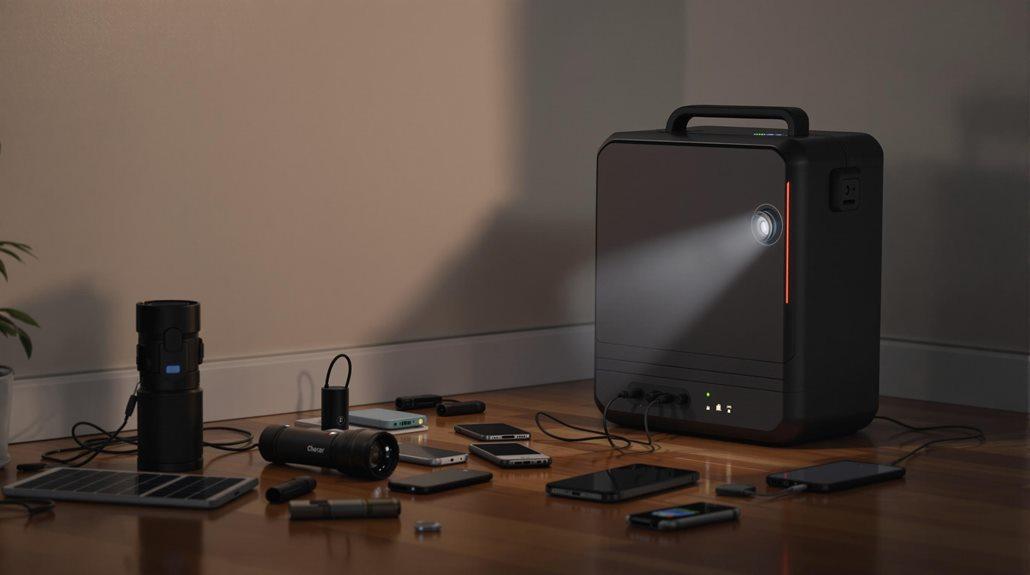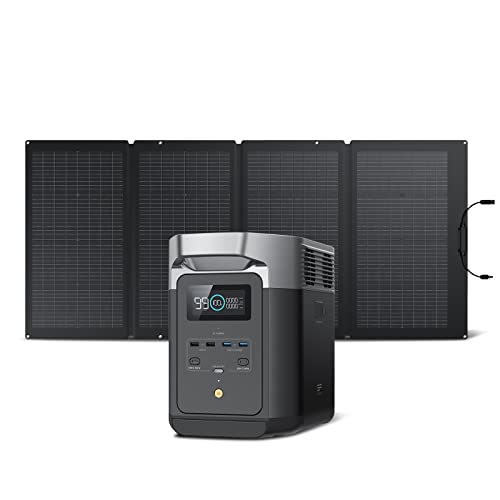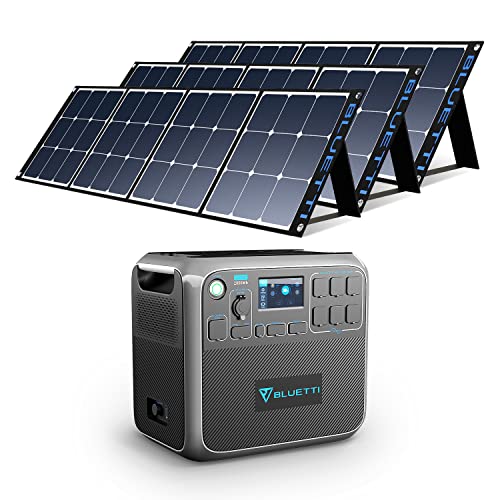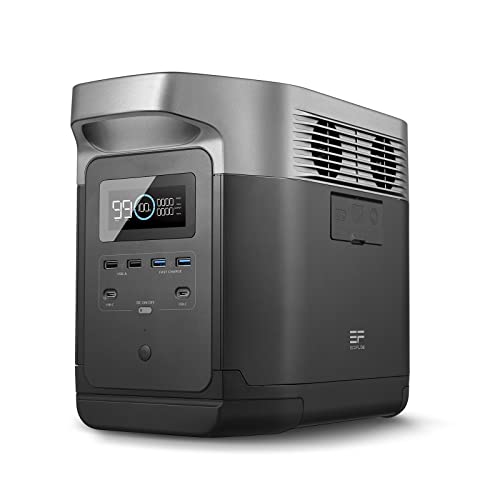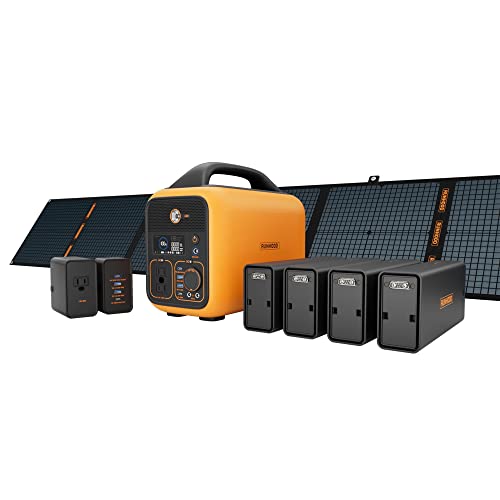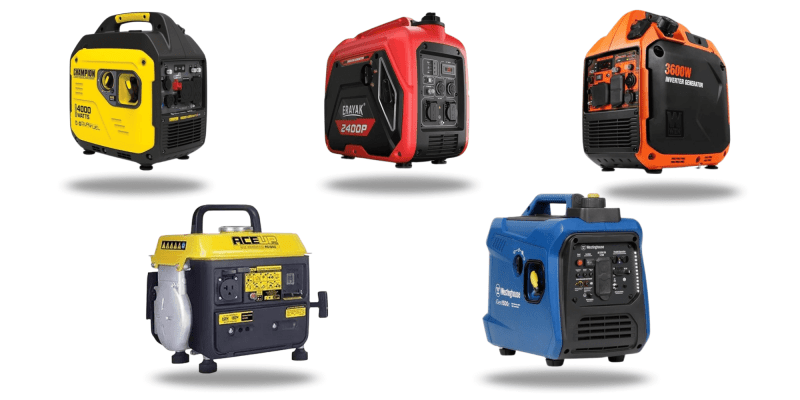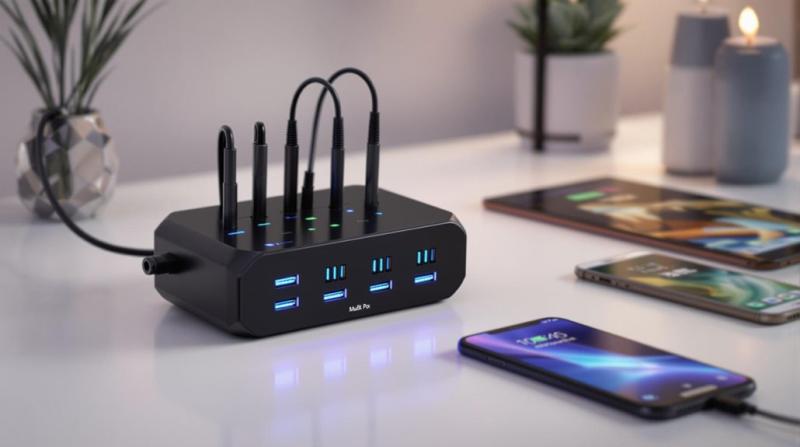If you're looking for the best portable home power backup, the EcoFlow Delta Pro is currently your top choice with its robust 3,600W output and versatile charging capabilities. This high-capacity station offers excellent reliability for whole-home backup needs, featuring advanced battery management systems and all-encompassing safety features. You'll get pure sine wave power delivery, multiple charging options including solar integration, and smart app monitoring for precise control. While it's a premium investment starting around $3,000, its expandable capacity and multi-circuit capabilities make it a standout option. Exploring the full range of features will help you understand why it's worth considering for serious backup power needs.
Key Takeaways
- The EcoFlow Delta Pro leads the market with 3,600W output and multi-circuit capabilities, making it ideal for comprehensive home backup needs.
- Premium stations with LiFePO4 batteries and advanced safety features provide reliable protection against power outages and electrical hazards.
- Mid-range power stations ($500-$1,500) offer balanced functionality with adequate runtime for essential appliances like refrigerators and electronics.
- Power stations with solar charging capabilities ensure sustainable backup power, with charging times averaging 7-8 hours using standard panels.
- Capacity ranges from 300-6000Wh, with 1,500Wh units providing sufficient power to run a refrigerator for up to 24 hours.
Understanding Power Station Categories
Power station selection hinges on matching your backup needs with the right category of portable power supply. Battery performance efficiency and substantially impact overall effectiveness when selecting portable power stations. When you're exploring portable stations, you'll find options ranging from compact 300-500Wh units for basic device charging to robust 6000Wh+ systems capable of whole-home backup power. Each category offers distinct features relative to battery capacity, power output, and connectivity options.
Budget-friendly models under $500 typically provide essential AC outlets and USB ports for device charging, while midsize options deliver expanded wattage output and longer runtime. Premium stations stand out with their battery expansion capabilities and advanced solar charging features, making them ideal for serious backup power needs. You'll need to evaluate the weight factor, as smaller units weigh 5-15 pounds, while all-encompassing backup systems can reach 100 pounds.
To determine the right category, assess your power requirements by looking at total power output needs, charging speed preferences, and the number of devices you'll need to run simultaneously. Your choice should balance portability with performance metrics like runtime and charging capabilities, ensuring you've got sufficient backup power for your specific situation.
Top Rated Power Stations Today
Market leaders in portable power stations have set new benchmarks for home backup solutions in 2024. The EcoFlow Delta Pro leads the pack with impressive 3,600W output wattage and the ability to power multiple home circuits during a power outage, making it a reliable emergency backup power solution. Its lithium battery technology and advanced features set it apart from traditional generators. The modular expandability options available in modern power stations allow for customized setups based on specific power needs.
For those seeking balanced performance, the Jackery Explorer 1000 v2 offers excellent battery capacity in a compact design, while the Goal Zero Yeti 1500X stands out with its smart connectivity features and extended runtime. If you're looking for all-encompassing off-grid capability, the Geneverse HomePower Two Pro comes bundled with solar panels, providing sustainable charging options and extended power availability.
Today's portable power stations offer markedly improved charge time and output capabilities compared to earlier models. You'll find features like app monitoring, multiple charging options, and varied port selections across these units. When choosing your power station, consider factors like battery capacity, output wattage, and whether you need solar compatibility for extended off-grid use.
$699.00
4.13 out of 5 starsEF ECOFLOW Solar Generator with 220W Panel
Efficient and Reliable Solar Power Station for All Your Charging Needs
Product information
Product Review Score
Product links
Capacity and Runtime Considerations
Understanding runtime capacity proves essential when selecting a portable power station for home backup needs. When you're evaluating power stations, the watt-hours rating directly determines how long your devices will stay powered during an outage. Pure sine wave inverters provide ideal power delivery for sensitive electronics, making them a paramount factor for home backup systems. For example, a power station with 1,500 watt-hours can run a standard refrigerator for 18-24 hours, while more robust models like the EcoFlow Delta Pro, with 3,600 watt-hours, deliver extended runtime under heavier loads.
Your power station's actual runtime will vary based on the connected devices' power draw. The Goal Zero Yeti 1500X demonstrates this well, providing over 28 hours of runtime for a 459-watt load. To maximize your backup power duration, you'll want to evaluate several factors: the lithium battery chemistry, total capacity, and potential for expansion. You can extend runtime substantially by implementing power conservation strategies and adding solar panel charging capabilities. When selecting your power station, carefully evaluate your essential devices' wattage requirements and choose a capacity that meets your specific backup needs, keeping in mind that higher-capacity units offer more flexibility during extended outages.
Essential Safety Features
Several critical safety features distinguish reliable portable power stations from subpar alternatives. When you're selecting a backup power solution, you'll want to prioritize models that use lithium iron phosphate battery chemistry, which markedly reduces the risk of thermal runaway and fire hazards compared to traditional lithium-ion batteries. Battery cycle longevity makes LiFePO4 batteries an excellent choice, offering over 2,000 cycles of reliable performance.
Look for all-encompassing battery management systems that actively monitor your unit's critical signs. These sophisticated systems track temperature, voltage, and current levels, automatically triggering safety protocols when needed. The most reliable models incorporate multiple layers of protection, including surge protection, overload protection, and short-circuit prevention. You'll also benefit from automatic shut-off features that instantly respond to potential electrical hazards, protecting both your power station and connected devices.
For outdoor use or emergency situations, consider power stations with IP65 ratings that guard against dust and water damage. This environmental protection adds another layer of safety to your backup power system. When evaluating safety features, confirm your chosen model includes a complete suite of protective measures, as these safeguards are essential for long-term reliability and peace of mind.
Solar Charging Capabilities
Modern portable power stations excel at harnessing solar energy through advanced charging capabilities. With solar input capacities ranging from 400W to an impressive 3000W, these battery backup solutions offer efficient renewable energy options for your home power needs. Most units feature built-in MPPT controllers that maximize energy conversion from your solar panels, ensuring you get the most out of every ray of sunlight. The mid-range power stations typically cost between $500-$1,500 and deliver excellent value for residential backup power.
When you're considering solar charging for your portable power station, you'll need to invest in compatible solar panel kits. Leading manufacturers like EcoFlow, Jackery, and Bluetti offer specially designed panels that work seamlessly with their units. Solar charging times vary by model, but you can expect a full charge in about 7-8 hours with standard systems, while high-end models with greater solar input capabilities charge markedly faster.
For reliable off-grid power, look for portable power stations that support higher solar input ratings. Models like the Anker Solix F3800, which accepts up to 3000W of solar input, provide exceptional charging speeds and enhanced energy independence. This makes them particularly valuable for both emergency backup and sustainable daily power management.
4.51 out of 5 starsBLUETTI AC200P Portable Power Station with Solar Panel Included 2000W Solar Generator Kit with 3pcs 200W Foldable Solar Panel, 6 120V AC Outlet Lithium Battery Backup for Home Use Outdoor Camping Van
The Ultimate Power Solution for Your Home, Outdoor Adventures, and Van Life
Product information
Product Review Score
Product links
Battery Technology Comparisons
While solar charging capabilities determine how quickly you can replenish your power station, the underlying battery technology shapes its long-term performance and reliability. Today's most advanced portable power backup solutions feature lithium iron phosphate (LiFePO4) batteries, which offer significant advantages over traditional lithium-ion cells.
When you're comparing battery technologies, you'll find that LiFePO4 chemistry stands out for its impressive 3,000-5,000 charge cycles while maintaining 80% capacity, making it a superior choice for long-term power backup needs. Battery capacity, measured in watt-hours, typically ranges from 300Wh to 2,000Wh, allowing you to select the right size for your specific requirements. Modern battery management systems provide holistic protection features, including temperature control and overcharge prevention, ensuring your investment stays safe and reliable. These advanced systems work seamlessly with solar charging capabilities, supporting energy regeneration rates up to 1,000W when paired with compatible solar panels. The combination of LiFePO4 technology and sophisticated battery management creates a power station that's not only safer but also more dependable for your emergency power needs.
Portable Power Station Setup
Setting up your portable power station correctly can mean the difference between reliable backup power and potential system failures. When choosing your unit, focus on finding one with sufficient capacity, typically between 1,000 and 2,000 watts, to handle your essential devices like refrigerators and medical equipment.
You'll want to place your power station in a cool, dry location near your home's electrical panel, making sure it's easily accessible but protected from moisture. Connect your critical devices directly to the AC outlets using appropriate cables, and create a priority list to manage power distribution during outages.
To guarantee continuous backup power, develop an all-encompassing charging strategy that includes multiple options. You can utilize wall outlets for everyday charging, solar panels for renewable energy during extended outages, and car charging adapters for mobility. Don't forget about regular maintenance every 3-6 months to keep your system running efficiently. This includes testing the battery capacity, cleaning connections, and checking all cables and ports for wear. Through proper setup and consistent maintenance, you'll maximize your power station's reliability when you need it most.
Power Output and Device Compatibility
Understanding power output capabilities and device compatibility is essential for effective home backup power. Modern power stations like the Anker Solix F3800 deliver impressive 6,000W output, letting you run multiple high-power devices during outages. You'll find that most quality portable units can consistently handle 300-600 watts, which is sufficient for essential appliances like refrigerators and medical equipment.
When selecting your power station, you'll want seek the variety of charging options available. Leading models offer multiple AC outlets, USB-A and USB-C ports to accommodate different devices. For example, the EcoFlow Delta 2 Max includes 6 AC outlets and various USB connections, making certain you can power everything from smartphones to laptops. You'll get approximately 50-90 smartphone charges or 10-15 laptop charges from a single power station charge, depending on the unit's battery capacity.
For more demanding emergency power needs, contemplate expandable models like the Jackery Explorer 1000 Plus, which supports 2,000W peak output. This higher capacity ensures you can run larger household electronics while maintaining reliable device compatibility during extended power outages.
Maintenance and Care Tips
Proper maintenance of your portable power station guarantees its longevity and reliable performance during emergencies. To maintain prime battery health, you'll need to clean the battery contacts and exterior surfaces regularly with a soft, dry cloth, confirming proper electrical connectivity and preventing dust buildup. It's paramount to schedule periodic power station maintenance, including a complete charge cycle every 3-6 months to preserve battery capacity and calibration.
When it comes to battery storage, keep your power station in a cool, dry place within a temperature range of 50-77°F. The battery chemistry in these units is sensitive to extreme conditions, so you'll want to avoid exposing your device to temperatures below 32°F or above 113°F, as this can cause permanent damage. Make sure you're regularly checking all cables, ports, and connectors for signs of wear or corrosion. If you notice any damage, replace these components immediately to maintain safe operation. By following these battery pack care guidelines, you'll extend your power station's lifespan and validate it's ready when you need it most.
Cost Versus Performance Analysis
After ensuring your power station is well-maintained, you'll want to evaluate which model offers the best value for your specific needs. When comparing cost versus performance, you'll find significant variations across different price points and capabilities.
The EcoFlow Delta Pro stands at the premium end, offering 3,600 watts of power and all-encompassing home backup capabilities for $3,600. While it's the most expensive option, its runtime and capacity make it ideal for whole-house power backup needs. At the mid-range, the Goal Zero Yeti 1500X provides excellent value at $1,299, with enough capacity to power essential appliances like refrigerators for extended periods. The Jackery Explorer 1000 v2 strikes a balance at $799, offering decent runtime and storage capacity for most household needs.
For budget-conscious buyers, the Anker 535 delivers basic power backup at $500, though it's limited to smaller devices. If you're looking for extended off-grid capability, the Geneverse HomePower Two Pro Solar Bundle, while pricier at $1,999, includes solar panels and offers the longest runtime, making it an excellent value for sustainable power backup solutions.
Frequently Asked Questions
What Is the Best Power Source During a Power Outage?
You'll want a backup battery system like the EcoFlow Delta Pro as your primary power source during outages. It's safer than traditional fuel reserve options and connects seamlessly to your electrical grid. For complete home protection, pair it with solar panels for alternative energy charging. Include it in your emergency kit alongside a reliable charging system - this combination guarantees you'll have a dependable power supply when you need it most.
Is a Portable Power Station Better Than a Generator?
For emergency prep and disaster readiness, you'll find a portable power station is often better than a generator. During power loss or grid failure, you'll appreciate its silent operation, zero emissions, and ability to use it safely indoors. While supporting your home resilience and energy independence goals, it offers convenient mobile charging and sustainable alternatives to traditional backup solutions. For off-grid living, you'll benefit from its lower maintenance needs and smart features.
How Long Will a Portable Power Station Run?
Your portable power station's runtime depends on its battery capacity and your energy consumption patterns. You'll get different backup durations based on your power needs and device compatibility - from 34 hours for a refrigerator to just 1-2 hours for high-draw appliances. To maximize efficiency metrics, consider load management and solar charging options. Runtime factors like temperature and usage patterns will affect performance, so it's important to match the station's capacity to your specific needs.
Is Bluetti or Jackery Better?
Like choosing between two powerful workhorses, your decision between Bluetti and Jackery depends on your specific needs. If you're prioritizing battery longevity and advanced technology, Bluetti's LiFePO4 batteries give you better value. However, if you're focused on portability and faster charging speeds, Jackery's your better bet. For outdoor adventures and emergency preparedness, both brands offer reliable solar integration and solid inverter quality, but Bluetti generally provides better price-to-performance value and all-encompassing customer support.
